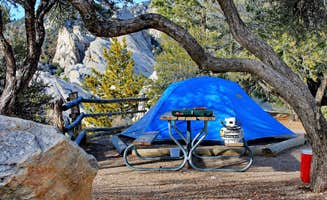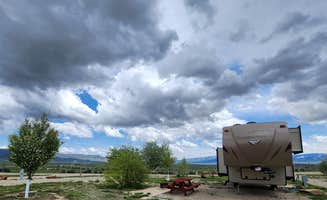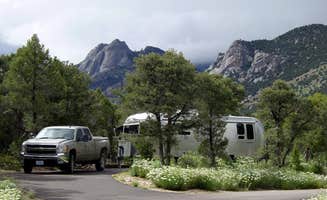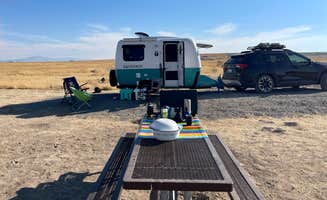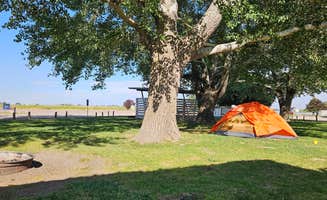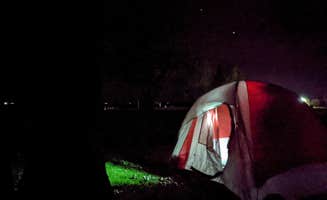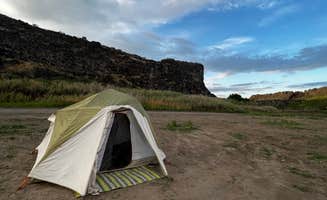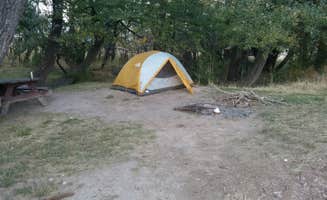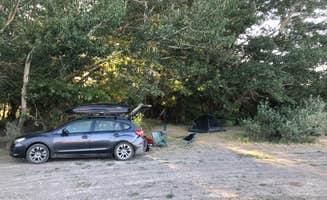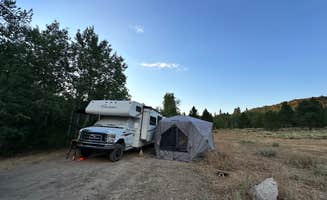Camping near Oakley, Idaho offers varied experiences between high mountain lakes at elevations over 8,000 feet and desert reservoir camping below 4,500 feet. Summer temperatures can range dramatically with mountain sites experiencing freezing nights even in July. Most primitive campsites lack water sources and cell service remains spotty throughout the region with best connectivity found at Thompson Flat Campground.
What to do
Fishing opportunities: Lake Cleveland sits at high elevation with crystal clear waters allowing visibility of trout swimming among rocks. According to one visitor, "We could see fish swimming among the rocks from 20' above on the road! Walking down to the lake there were even more trout than we had initially seen, so it would be a shame not to bring a pole up here!"
Cliff jumping: The Snake River at Milner Historic Recreation Area offers calm water suitable for paddleboarding with some small rock formations for adventurous swimmers. "We spent lots of time on the water and even paddled across to some rocks and did a little cliff jumping (they aren't too high)," reports one camper who visited the area.
Hiking trails: Independence Lakes offers challenging trails with significant elevation gain. A reviewer notes: "It's a 2.5 mile hike to the first lake. It inclines all the way up. You are treated with beautiful back country views, met with several switch backs before reaching the first lake. There are 3 lakes and past the 3rd lake you are able to hike up to the top towards the cliff rocks."
Waterfall exploration: Cauldron Linn BLM features dramatic lava rock formations and waterfalls accessible via a short walk. "You need to walk up the rocks and follow the path to the water falls. It is an easy walk on the path or you can climb some rocks. It is a short walk to see the most amazing lava rock formations and the canyon," explains one visitor.
What campers like
Privacy between sites: Most campers appreciate the spacing between sites at many campgrounds. At Smoky Mountain Campground, "The sites are very private and nicely spread out with pine trees in between. Great views of City of Rocks," according to one reviewer. Another adds, "We had a little trouble finding the campground, but that was because of human error when selecting the route via Google Maps."
Star visibility: The dark skies throughout the region provide exceptional stargazing opportunities. One camper at Smoky Mountain Campground calls it "A star gazer's dream." At Lake Cleveland East, campers enjoy "High elevation experience with mountain and lake views."
Free dispersed options: For budget-conscious campers, the area offers numerous free sites. At Lower Goose Creek Reservoir, "The campgrounds are right on the reservoir and open and spacious. It's a great spot to fish all day, light a campfire and gaze under the stars."
Unexpected canyon beauty: Cauldron Linn surprises visitors with its dramatic landscape. "One moment you are driving through farmland. The next moment a canyon appears out of nowhere. There is a beach there are waterfalls and the views are absolutely amazing," writes one visitor.
What you should know
Road conditions: Many access roads deteriorate significantly after rainfall. At Cauldron Linn, "The road down is definitely steep and bumpy in places, take care," warns one camper. Another notes: "Farm road to BLM awash with loads of potholes but can be navigated cautiously. Once at the Cauldron, do not go down to the river unless you have 4WD."
Seasonal considerations: Most facilities close during winter months. According to one visitor at Castle Rocks State Park, "We were disappointed to find that all the water and restroom facilities were closed during the winter."
Temperature extremes: Mountain camping can be significantly colder than valley locations. A City of Rocks visitor observed: "We stayed with our 2 dogs in April, it was definitely warm in the sun, but very cool at night and in the shade. It is high desert, summer months must be stifling!"
Insect issues: Flies can be problematic in certain locations during summer. At Cauldron Linn, one camper reports: "Beautiful and peaceful but watch out for the flys. This site was a one night stop but I would've stayed a bit longer if I could've it was quiet with some good views of the Snake river and the surrounding canyon walls. The one downside is there is a large amount of flys at this site."
Tips for camping with families
Pack for variable conditions: Temperature fluctuations require layering options. At City of Rocks, one camper advises: "Head down to the City if you're looking for some wide open space and solitude, the campground is SO spread out you will never notice if it's full. City of Rocks is…well rocky, so definitely be prepared to use rocks or other heavy things to help stake out your tents/ezups, which trust me, you'll want to—the wind and lack of shade make those extra shelters a must!"
Consider shoulder seasons: Summer heat can be intense at lower elevations while spring and fall offer milder conditions. A visitor notes: "Great family camping. Gets hot in July-August. Lots of hiking and exploring to do. Main recreation activity is rock climbing. Durfee Hotsprings in Almo is a must on any visit."
Choose sites based on shade: Summer sun exposure impacts comfort significantly. "Take your time in picking out a good camping spot. Shade is key in the summer months. Use the 'Shade Legend' on the NPS site," recommends one experienced camper.
Explore local history: Educational opportunities abound with Oregon Trail history at Milner Recreation Area and emigrant names at City of Rocks. "It was interesting to see the emigrants' names on the rocks and imagining them arrive in this small valley of strange formations," shares one visitor.
Tips from RVers
Check site dimensions: Many campgrounds have limited large rig access. An RVer at Thompson Flat Campground notes: "We had a fantastic time and our dogs loved it too. We were one of 3 campsites in use during out stay in the last half of September. We never saw a camphost anywhere, but the forest service were thinning trees during out stay."
Water management: Most sites lack hookups requiring self-sufficiency. At Oakley City RV Park, "Power and water at each site, and a free sewer dump. They also have a restroom with running water and 2 individual shower bays that you can access with a code."
Cell service variability: Connectivity fluctuates by location with better service at higher elevations. Thompson Flat Campground offers surprisingly good connectivity: "You are in direct line with a tower on another mountain peek to the East and we got excellent signal for both cell and tv."
Seasonal facility closures: Check ahead for water availability. One RVer at Castle Rocks State Park reports: "Water not yet turned on in the campground so bring your own water if you are coming through early in the season."


